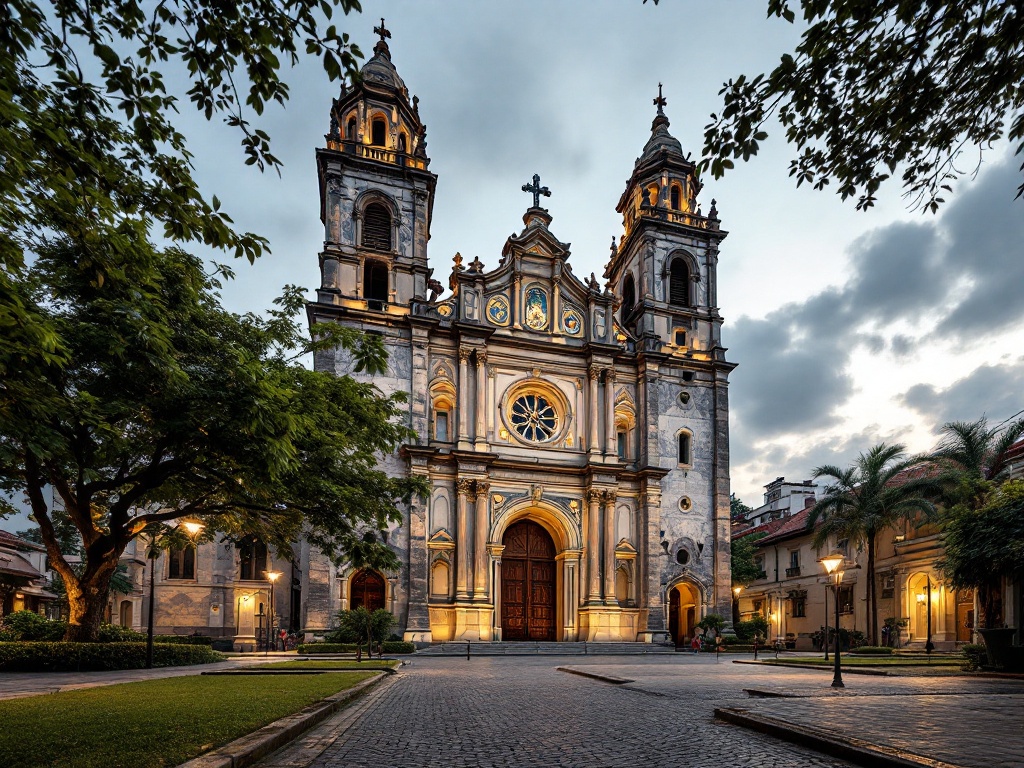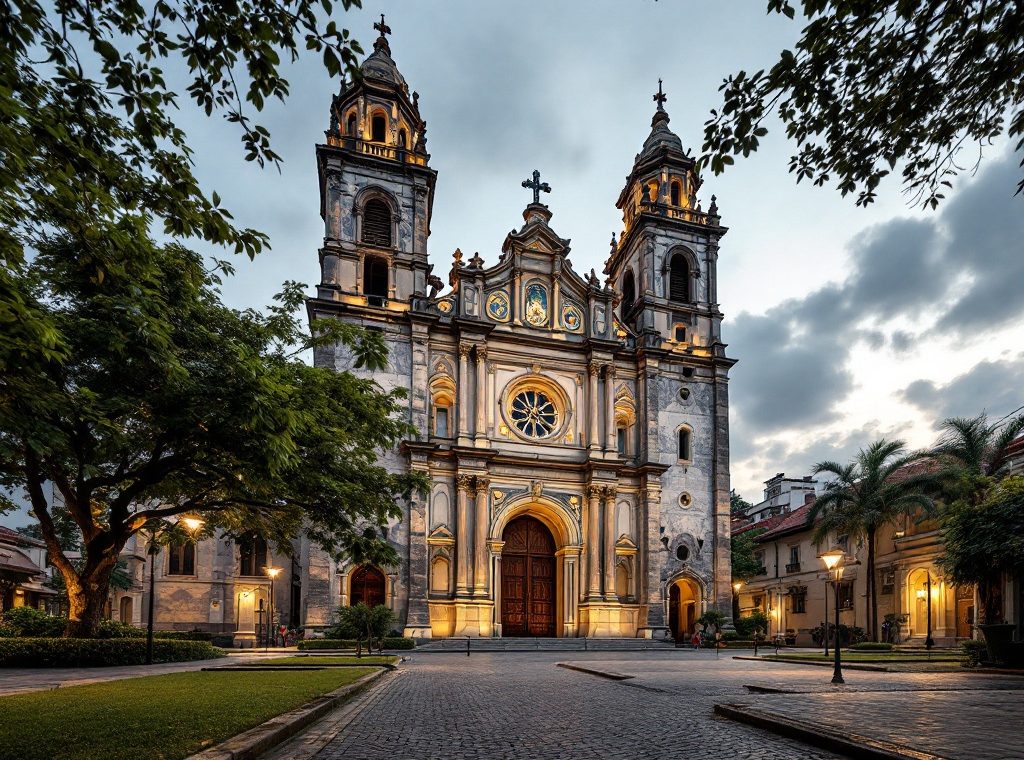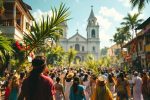San Agustin Church: Complete Guide to the Oldest Church in the Philippines
Journey back in time to 1607 at the San Agustin Church, the Philippines’ oldest stone church, a UNESCO World Heritage Site located in the heart of historic Intramuros, Manila. Discover a breathtaking Baroque masterpiece, resiliently standing after centuries of earthquakes and wars. Explore its stunning trompe-l’œil murals, grand altar, and ornate carvings, and uncover the stories of prominent figures laid to rest within its walls. Plan your visit today to experience this architectural and historical marvel, and delve into the captivating San Agustin Church Museum.
Important information

- San Agustin Church, located in Intramuros, Manila, is the oldest stone church in the Philippines, completed in 1607.
- It’s a UNESCO World Heritage Site, recognized for its Baroque architecture, featuring trompe-l’œil murals and a grand altar.
- The church survived numerous disasters, including earthquakes and WWII bombings, due to its adobe stone and lime mortar construction.
- It houses the remains of prominent figures like Miguel López de Legazpi and Juan Luna.
- The adjacent San Agustin Museum showcases Spanish Colonial artifacts. Church entry is free; the museum has a fee.
Introduction to San Agustin Church
Located in Manila’s historic Intramuros district, San Agustin Church is the oldest stone church in the Philippines. It is a remarkable architectural achievement.
Location in Intramuros, Manila
Located within Manila’s historic Intramuros, the walled city renowned for its Spanish colonial architecture, San Agustin Church stands as a significant landmark, embodying the area’s rich heritage.
Completion and Historical Background
Construction of San Agustin Church began in the 1570s by Augustinian priests and was completed on January 19, 1607. The church is renowned for its historical significance.
Dedication to Saint Augustine of Hippo
The San Agustin Church is dedicated to Saint Augustine of Hippo, a prominent theologian and philosopher of the late Roman era. His influence on Western Christianity was profound. His writings on theology and philosophy left a lasting legacy.
Architectural Significance of San Agustin Church
San Agustin Church, renowned for its Baroque style, features elaborate carvings and a magnificent facade. Neoclassical-Baroque elements enrich the design, reflecting the church’s captivating history and the artistry of Spanish and Filipino craftsmen. The church’s grandeur is further amplified by massive buttresses, trompe-l’œil murals, and a vaulted ceiling. Gilded altars add a touch of splendor. The structure is constructed of adobe stone and lime mortar.
Baroque Architecture and Design
San Agustin Church is a breathtaking example of Baroque architecture, boasting a richly detailed facade. The interior is even more elaborate, featuring stunning trompe-l’œil murals and gleaming gilded altars beneath a magnificent vaulted ceiling. The design seamlessly blends local and European elements, reflecting the church’s Spanish colonial past and creating a truly awe-inspiring experience for visitors.
Distinct Architectural Features
The church’s architecture is truly stunning, from its barrel vault and ornate carvings to impressive trompe-l’oeil murals. Chapels flank the nave, while elliptical arches support the choir loft above, complete with carved wooden stalls and a lectern. This grand design reflects the church’s rich history and stands as a significant example of Baroque style, a defining influence on the era’s cultural landscape.
Construction Materials: Adobe Stone and Lime Mortar
Built with locally sourced adobe stone and lime mortar, the church showcases enduring construction techniques. This robust blend ensures structural soundness.
The use of these materials underscores the church’s historical significance.
Ornate Carvings, Grand Altar, and Ceiling Murals
Step inside the church and be captivated by the intricate carvings. A grand altar commands attention, while overhead, trompe-l’oeil murals by 19th-century Italian artist Giovanni Battista Ghezzi adorn the ceiling, replacing earlier damaged artwork.
Survival and Resilience Through Natural Disasters
San Agustin Church stands as a testament to resilience, having survived earthquakes, fires, and even the bombings of World War II. Its remarkable durability comes from the ingenious use of adobe stones and lime mortar in its construction.
Historical Significance of San Agustin Church
Completed in 1607, the San Agustin Church is the Philippines’ oldest stone church, its construction began in 1586.
Throughout the Spanish colonial era, this historic edifice witnessed numerous significant events.
It even served as a protective fortress during periods of conflict.
The church also houses the remains of important Spanish officials and other notable figures within its venerable walls.
It stands as a powerful testament to Philippine history.
Role in the Spanish Colonial Period
During the Spanish colonial era in the Philippines, San Agustin Church served as a vital center for religious conversion. It administered sacraments and fostered cultural exchange between Spanish colonizers and Filipinos. Its influence was profound.
Final Resting Place of Notable Figures
San Agustin Church is the final resting place of many important figures in Philippine history. Some of the most notable are Miguel López de Legazpi, the first Spanish Governor-General of the Philippines, and the celebrated artist, Juan Luna. Numerous other key figures from the nation’s history and culture are also interred within its walls.
San Agustin Church as a UNESCO World Heritage Site
The San Agustin Church, a UNESCO World Heritage Site since 1993, reflects the Philippines’ rich cultural heritage and historical importance. Its designation as one of the “Baroque Churches of the Philippines” underscores its significance during the colonial era. The church’s architecture beautifully blends European and local styles.
Designation and Cultural Heritage
A UNESCO World Heritage Site, the San Agustin Church represents a unique blend of European and Filipino architectural traditions. It reflects its historical significance as part of the “Baroque Churches of the Philippines”.
This designation acknowledges the church’s role in preserving cultural narratives, particularly those of the country’s colonial past. Its design eloquently speaks to a story of cultural exchange and adaptation, a narrative further reinforced by its continued presence for future generations.
The World Heritage status also underscores the critical need for preservation efforts to safeguard this vital piece of history.
Recognition as a National Historical Landmark
In 1976, the Philippine government recognized the historical significance of San Agustin Church by designating it a National Historical Landmark. This solidified the church’s crucial role in the nation’s history.
San Agustin Church Museum
Step into the captivating world of the San Agustin Church Museum and uncover a remarkable collection of Spanish Colonial artifacts and artwork. Explore ancient manuscripts, religious icons, and stunning colonial art, each piece offering a glimpse into the rich history of the Philippines. These relics vividly bring the past to life, providing a unique window into the country’s vibrant heritage.
Spanish Era Artifacts and Artworks
Step into the San Agustin Church Museum and discover a captivating collection of religious artifacts from the Spanish colonial era. Explore statues, paintings, and vestments that offer a glimpse into the religious practices and artistic styles of the period. These remarkable items showcase the rich history and artistry of the time.
Visiting Information: Opening Hours and Entrance Fee
San Agustin Church
open daily from 8:00 AM to 6:00 PM, free admission.
San Agustin Museum
open Tuesday through Sunday from 8:00 AM to noon and 1:00 PM to 5:00 PM, 200-peso entrance fee.
Opening hours are subject to change, especially during holidays or special events.
Visiting San Agustin Church
Visit the San Agustin Church in Intramuros, Manila, for a spiritual or architectural experience. The church is easily accessible by jeepney, taxi, or tricycle. Inside, admire the stunning architecture or attend a service. Guided tours, often including nearby historical sites, are available. Entrance to the church is free, while the adjacent San Agustin Museum requires a fee. Access may be restricted during mass or weddings.
Religious Services and Sightseeing
Step inside the historic San Agustin Church, a welcoming space for both prayer and exploration. Regular masses are held, along with special services for Christmas and Easter. Throughout the year, the church also hosts weddings, special events, and cultural performances.
How to Get There
Getting to San Agustin Church in Intramuros, Manila is easy. You can choose from various public transportation options.
Public transport: jeepneys, LRT Line 1.
Convenient options: taxis, ride-hailing services.
Many guided tours also include a visit to the church. For those arriving from the airport, consider these options:
- pre-booked private transfer,
- pre-arranged tour,
- taxis and ride-hailing apps.
Nearby Attractions
Near San Agustin Church, history buffs can explore Casa Manila, a beautifully preserved colonial house. Nearby, Fort Santiago offers a glimpse into the city’s captivating past.
- Plaza Moriones is another must-visit spot.
- Delve into Chinese-Filipino history at Bahay Tsinoy.
- Several museums within Intramuros provide further historical context.
The architectural marvel of Manila Cathedral is also not to be missed. These landmarks collectively showcase Manila’s rich and diverse cultural heritage.
Wedding Rates and Policies
Planning your wedding at the historic San Agustin Church? Here’s a step-by-step guide to help you prepare:
Gather essential documents. These include your Baptismal and Confirmation Certificates, Marriage License, and Certificate of Freedom to Marry.
Complete the necessary requirements. You’ll need to attend a Canonical Interview and a Pre-Cana Seminar.
Submit your list of sponsors. Ensure all required information for your chosen sponsors is included.
Consider the wedding costs. These typically range from P20,000 to P40,000, covering various services and individual requests.















